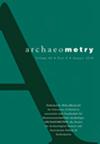墨西哥El Paredón黑曜岩次源变异性特征
IF 1.5
3区 地球科学
0 ARCHAEOLOGY
引用次数: 0
摘要
对墨西哥特拉斯卡拉(Tlaxcala)五个形成期(公元前1200年至公元前100年)遗址的黑曜石进行便携式x射线荧光(pXRF)地球化学分析,发现大多数物质与最近的黑曜石来源(El Paredón, Puebla)中发现的物质具有相似的价值。然而,最初的分析并不能确定这些物质是来自同一个火山口还是来自一个特定的黑曜岩矿床。在这里,我们提出了一种方法,允许黑曜石子源的识别。结果显示,特拉斯卡兰种群利用了普埃布拉州一个名为特雷斯卡贝萨斯的特殊黑曜岩矿床,为确定相关的区域交换网络提供了有价值的新数据。本文章由计算机程序翻译,如有差异,请以英文原文为准。
Characterisation of obsidian subsource variability at El Paredón, Mexico
Portable X-ray fluorescence (pXRF) geochemical analysis on obsidian from five Formative period (1200 BCE to AC 100) sites from Tlaxcala, Mexico, has revealed that most of the material had similar values to those found in the closest obsidian source, named El Paredón, Puebla. Nevertheless, initial analyses did not resolve whether these materials came from the same caldera or from a specific obsidian deposit. Here we present a methodology that allows the identification of obsidian subsources. The results reveal that Tlaxcalan populations took advantage of a specific obsidian deposit called Tres Cabezas, Puebla, providing valuable new data to identify associated regional exchange networks.
求助全文
通过发布文献求助,成功后即可免费获取论文全文。
去求助
来源期刊

Archaeometry
地学-地球科学综合
CiteScore
3.60
自引率
12.50%
发文量
105
审稿时长
6 months
期刊介绍:
Archaeometry is an international research journal covering the application of the physical and biological sciences to archaeology, anthropology and art history. Topics covered include dating methods, artifact studies, mathematical methods, remote sensing techniques, conservation science, environmental reconstruction, biological anthropology and archaeological theory. Papers are expected to have a clear archaeological, anthropological or art historical context, be of the highest scientific standards, and to present data of international relevance.
The journal is published on behalf of the Research Laboratory for Archaeology and the History of Art, Oxford University, in association with Gesellschaft für Naturwissenschaftliche Archäologie, ARCHAEOMETRIE, the Society for Archaeological Sciences (SAS), and Associazione Italian di Archeometria.
 求助内容:
求助内容: 应助结果提醒方式:
应助结果提醒方式:


